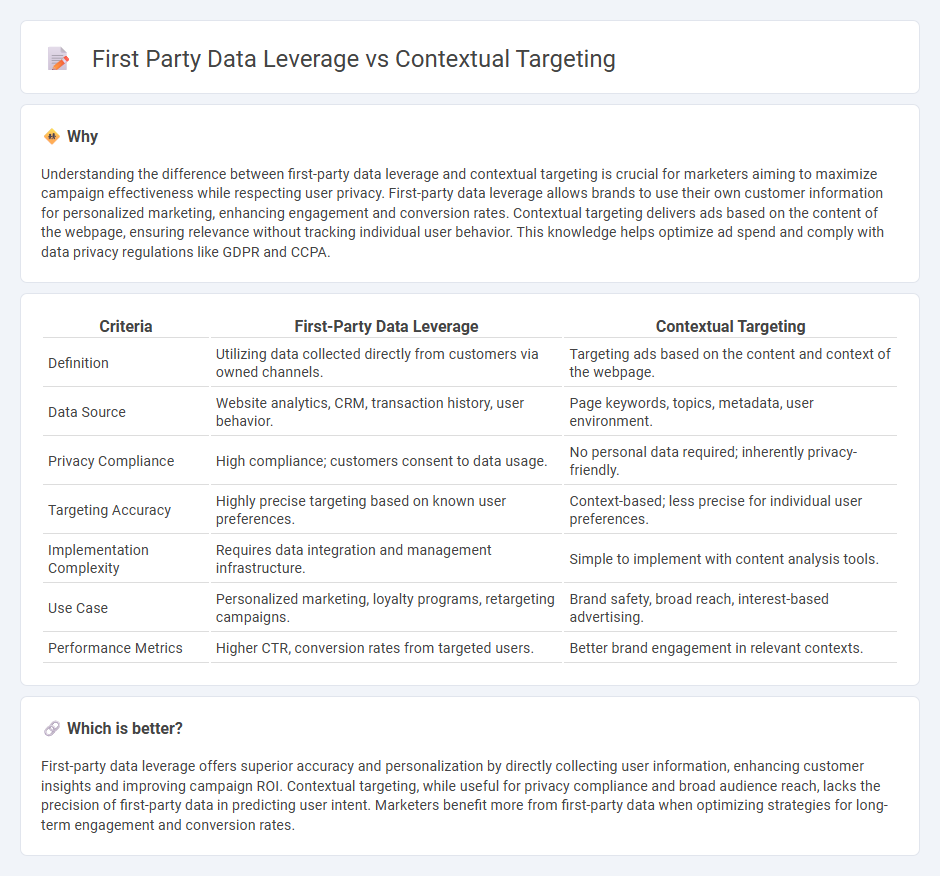
First-party data leverages directly collected customer information to deliver personalized and highly targeted marketing campaigns that improve engagement and conversion rates. Contextual targeting uses real-time analysis of the content surrounding ads to match messaging with relevant environments, enhancing brand safety and immediate relevance without relying on user data. Explore the advantages and strategic applications of first-party data versus contextual targeting to optimize your marketing efforts.
Why it is important
Understanding the difference between first-party data leverage and contextual targeting is crucial for marketers aiming to maximize campaign effectiveness while respecting user privacy. First-party data leverage allows brands to use their own customer information for personalized marketing, enhancing engagement and conversion rates. Contextual targeting delivers ads based on the content of the webpage, ensuring relevance without tracking individual user behavior. This knowledge helps optimize ad spend and comply with data privacy regulations like GDPR and CCPA.
Comparison Table
| Criteria | First-Party Data Leverage | Contextual Targeting |
|---|---|---|
| Definition | Utilizing data collected directly from customers via owned channels. | Targeting ads based on the content and context of the webpage. |
| Data Source | Website analytics, CRM, transaction history, user behavior. | Page keywords, topics, metadata, user environment. |
| Privacy Compliance | High compliance; customers consent to data usage. | No personal data required; inherently privacy-friendly. |
| Targeting Accuracy | Highly precise targeting based on known user preferences. | Context-based; less precise for individual user preferences. |
| Implementation Complexity | Requires data integration and management infrastructure. | Simple to implement with content analysis tools. |
| Use Case | Personalized marketing, loyalty programs, retargeting campaigns. | Brand safety, broad reach, interest-based advertising. |
| Performance Metrics | Higher CTR, conversion rates from targeted users. | Better brand engagement in relevant contexts. |
Which is better?
First-party data leverage offers superior accuracy and personalization by directly collecting user information, enhancing customer insights and improving campaign ROI. Contextual targeting, while useful for privacy compliance and broad audience reach, lacks the precision of first-party data in predicting user intent. Marketers benefit more from first-party data when optimizing strategies for long-term engagement and conversion rates.
Connection
First-party data provides detailed insights into user behavior and preferences, enabling marketers to create highly relevant audience segments. Leveraging this data enhances contextual targeting by allowing brands to deliver personalized ads that align with the content environment and user intent. This synergy improves ad precision, boosts engagement rates, and maximizes return on investment in digital marketing campaigns.
Key Terms
Relevance
Contextual targeting increases ad relevance by delivering content aligned with the page's theme, ensuring users see ads related to their immediate interests without relying on personal data. First-party data leverage enhances relevance through precise audience segmentation based on customer behavior, preferences, and purchase history, enabling highly tailored ads. Explore deeper insights into how these strategies optimize advertising effectiveness and privacy compliance.
Privacy
Contextual targeting respects user privacy by delivering ads based on the content of the webpage rather than personal data, avoiding the need for tracking cookies or extensive data collection. First-party data leverage involves using data collected directly from user interactions, ensuring higher accuracy but requiring stringent compliance with privacy regulations like GDPR or CCPA. Explore how these approaches balance advertising effectiveness with privacy protection.
Personalization
Contextual targeting uses real-time environmental data to deliver ads relevant to the content being consumed, enhancing user engagement without relying on personal data. First-party data leverage enables brands to personalize experiences by utilizing their own collected customer insights, leading to more tailored and effective marketing strategies. Explore how blending these approaches can maximize personalization impact and drive superior marketing outcomes.
Source and External Links
Contextual Advertising Guide - This guide explains how contextual targeting works by analyzing the content of web pages to match relevant ads without relying on user data.
Contextual Advertising Blog - This blog post outlines the process of contextual targeting, which involves selecting parameters such as keywords and topics to target relevant audiences.
Contextual Targeting Insider - This article discusses how contextual targeting helps advertisers reach audiences based on specific interests and events by focusing on the content context rather than user behavior.
 dowidth.com
dowidth.com